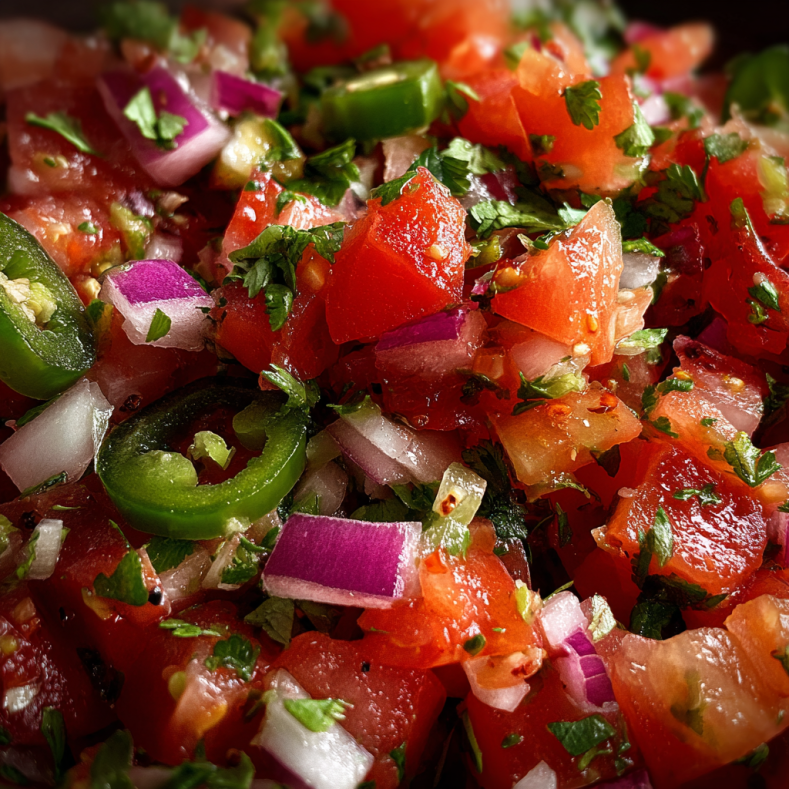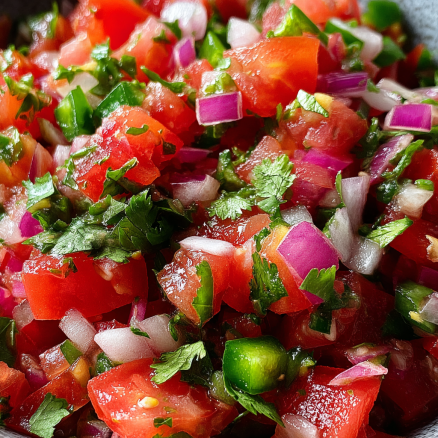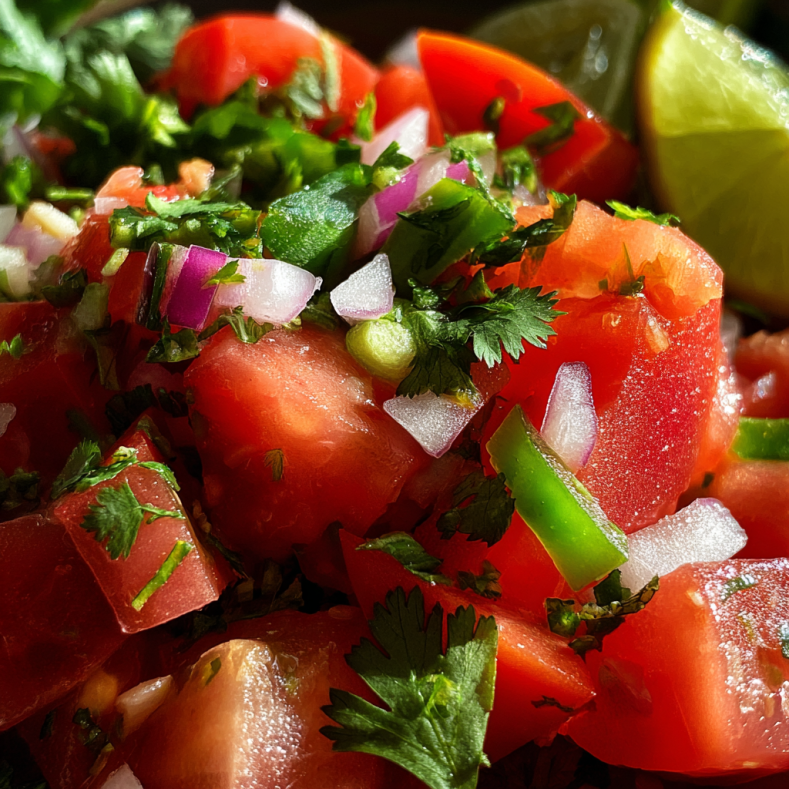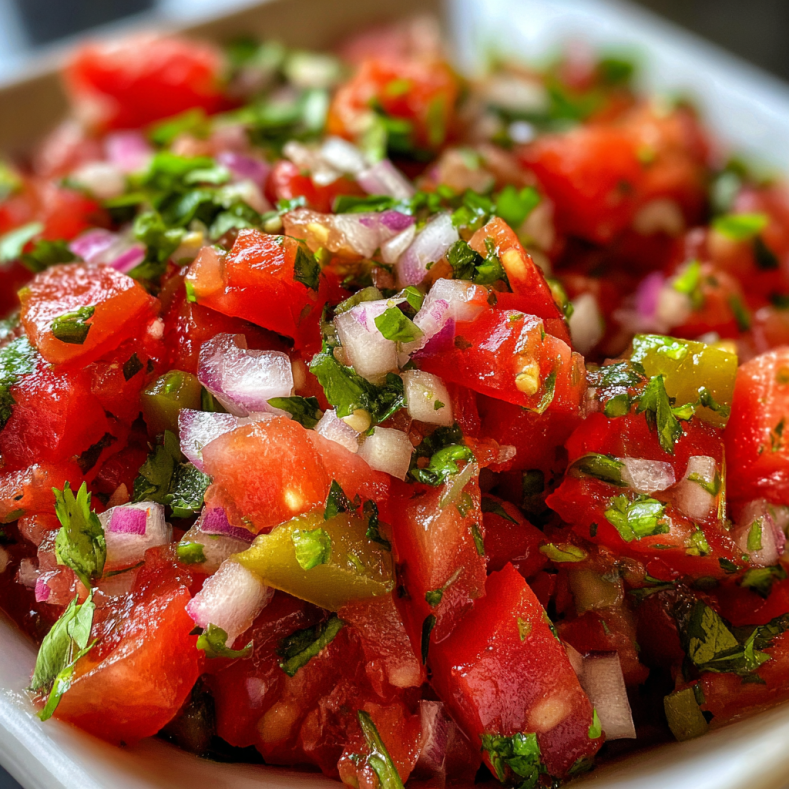There’s something magical about the moment fresh tomatoes, crisp onions, and vibrant cilantro come together with a squeeze of lime juice. This isn’t just another condiment sitting in your refrigerator – this is pico de gallo, the crown jewel of Mexican cuisine that transforms everything it touches. Whether you’re planning a backyard barbecue, craving authentic Mexican flavors, or simply wanting to add brightness to your weeknight dinner, this fresh homemade pico de gallo delivers restaurant-quality results with ingredients you probably already have in your kitchen.
Top Reasons Why You’ll Love This Homemade Pico de Gallo

This recipe represents everything we love about authentic Mexican cooking: bold flavors achieved through the perfect balance of fresh ingredients, simplicity that doesn’t sacrifice taste, and versatility that makes it suitable for countless occasions. Unlike store-bought versions loaded with preservatives and artificial flavors, homemade pico de gallo celebrates the natural sweetness of ripe tomatoes, the sharp bite of fresh onions, and the aromatic punch of cilantro.
The beauty lies in its flexibility – this recipe serves as your foundation, but you control the heat level, the chunk size, and even the balance of flavors to match your family’s preferences. It’s ready in less than fifteen minutes, requires no cooking whatsoever, and actually improves as it sits, making it perfect for meal prep or entertaining.
What truly sets this version apart is how it captures that authentic restaurant taste that makes you wonder why you ever bought jarred salsa. The secret lies in understanding the proper ratios, choosing the right tomato varieties, and mastering the simple techniques that maximize flavor while maintaining that perfect chunky texture that gives pico de gallo its distinctive character.
What Is Pico De Gallo?
Pico de gallo, literally translated as “rooster’s beak,” is a fresh Mexican salsa that showcases the pure, unadulterated flavors of its ingredients. Unlike cooked salsas that blend flavors through heat, pico de gallo celebrates the individual character of each component while creating harmony through careful balance and proper preparation.
Traditional pico de gallo consists of diced tomatoes, white onions, jalapeño peppers, fresh cilantro, and lime juice, all brought together with a generous pinch of salt. The magic happens in the proportions – enough tomatoes to provide sweetness and body, sufficient onions to add sharp contrast, just the right amount of jalapeños for heat without overwhelming, and cilantro that brightens everything without dominating.
This condiment originated in Mexican cuisine as a way to preserve and celebrate fresh ingredients, particularly during tomato season when gardens overflow with ripe, flavorful fruit. It represents the Mexican culinary philosophy of letting high-quality ingredients speak for themselves rather than masking their natural flavors with heavy seasonings or complicated preparations.
What’s the Difference Between Pico de Gallo and Salsa?

Understanding the distinction between pico de gallo and salsa helps explain why this particular preparation holds such a special place in Mexican cuisine. The primary difference lies in texture and preparation method – pico de gallo maintains distinct, chunky pieces that allow you to taste each ingredient individually, while traditional salsas often involve blending or cooking that creates more uniform flavor distribution.
Salsa encompasses a broad category of sauces that can be smooth, chunky, cooked, or raw, and may include ingredients like tomatillos, roasted peppers, or various spices. Many commercial salsas undergo cooking processes that concentrate flavors but sacrifice the fresh, crisp texture that defines authentic pico de gallo.
Temperature also plays a role in the distinction. While salsas can be served hot, room temperature, or cold, pico de gallo is traditionally served fresh and cool, highlighting the crisp textures and bright flavors of its raw ingredients. The preparation method differs too – pico de gallo requires knife work rather than blending, ensuring each ingredient maintains its integrity while contributing to the overall flavor profile.
How To Make Pico De Gallo Chunky Salsa
The process of making exceptional pico de gallo begins long before you pick up a knife. Success starts with ingredient selection – choosing tomatoes at peak ripeness, onions with sharp flavor, and jalapeños with the heat level that matches your preferences.
Begin by washing and thoroughly drying all your produce. Proper drying prevents excess moisture from making your pico de gallo watery, which is one of the most common mistakes home cooks make. Core your tomatoes and remove the seeds and surrounding gel – this step is crucial for maintaining the right consistency and preventing your finished pico from becoming soggy.
Dice your tomatoes into uniform pieces, roughly quarter-inch cubes. Consistency in size ensures even flavor distribution and attractive presentation. The onions should be diced slightly smaller than the tomatoes, creating textural variety while ensuring you get onion flavor in every bite without overwhelming chunks.
For the jalapeños, remove seeds and membranes if you prefer milder heat, or leave them in for more intensity. Mince the peppers finely – you want their heat and flavor distributed throughout rather than concentrated in large pieces that might catch someone by surprise.
Fresh cilantro should be roughly chopped, with pieces large enough to provide bursts of flavor but small enough to distribute evenly. Combine everything in a bowl, squeeze fresh lime juice over the mixture, season generously with salt, and gently fold everything together. Let it rest for at least fifteen minutes before serving to allow flavors to meld and develop.
Ingredients
Core Ingredients:
- 4 large ripe tomatoes (Roma or vine-ripened work best)
- 1 medium white onion, finely diced
- 2-3 jalapeño peppers (adjust to taste preference)
- 1/2 cup fresh cilantro, roughly chopped
- 2-3 fresh limes, juiced
- 1 teaspoon kosher salt (or to taste)
Optional Flavor Enhancers:
- 2 cloves garlic, minced
- 1/4 teaspoon ground cumin
- 1/4 teaspoon black pepper
- 1 small serrano pepper for extra heat
- 1 tablespoon olive oil for richness
Tips for Making the Best Pico De Gallo
The difference between good pico de gallo and extraordinary pico de gallo lies in mastering several key techniques that professional cooks understand instinctively.
Choose your tomatoes wisely. Roma tomatoes offer the ideal balance of flavor and low moisture content, making them perfect for pico de gallo. If using larger tomatoes, select varieties that feel heavy for their size and yield slightly to gentle pressure – signs of ripeness without being overripe.
Remove tomato seeds and gel completely. This step cannot be emphasized enough. The gel surrounding tomato seeds contains most of the excess moisture that can make your pico de gallo watery and diluted. Cut tomatoes in half, scoop out seeds and gel with a spoon, then proceed with dicing.
Salt the tomatoes separately first. Professional chefs often salt diced tomatoes and let them drain in a colander for 15-20 minutes before adding other ingredients. This draws out excess moisture while concentrating flavors.
Use the right onion variety. White onions provide the sharp, clean flavor that complements rather than competes with other ingredients. Yellow onions can work but tend to be sweeter, while red onions can overpower delicate tomato flavors.
Adjust heat gradually. Start with less jalapeño than you think you need – you can always add more, but you can’t take it back. Remember that heat develops over time as the pico sits.
Don’t overdress. Fresh lime juice is essential, but too much can make the mixture soggy and overly acidic. Start with the juice of one lime and add more as needed.
Let it rest. Allowing pico de gallo to sit for 30 minutes to an hour before serving lets flavors meld and develop. However, it’s best consumed within 24 hours while vegetables maintain their crisp texture.
How To Serve Homemade Pico De Gallo

The versatility of fresh pico de gallo extends far beyond its traditional role as a tortilla chip companion. While it certainly excels in that capacity, thinking of it only as a dip limits its incredible potential to elevate countless dishes.
As a condiment, pico de gallo transforms grilled meats, fish, and poultry with its bright acidity and fresh flavors. Spoon it over grilled chicken breasts, fish tacos, or carne asada for instant restaurant-quality results. It works equally well with breakfast dishes – try it over scrambled eggs, breakfast burritos, or huevos rancheros.
In Mexican cuisine, it’s essential for authentic tacos, quesadillas, nachos, and tostadas. The fresh crunch provides textural contrast to rich, cheesy, or creamy elements while the acidity cuts through heavy flavors.
For fusion applications, consider pico de gallo as a fresh salsa for grilled vegetables, a topping for baked potatoes, or mixed into grain bowls and salads. It adds brightness to rich dishes like mac and cheese or loaded baked potatoes.
Temperature matters – serve pico de gallo chilled or at room temperature, never hot. The cool, crisp texture is part of its appeal and heating destroys the fresh character that makes it special.
Common Q + A’s for Fresh Homemade Pico de Gallo
How long does homemade pico de gallo last? Fresh pico de gallo is best consumed within 24-48 hours of preparation. After that, the vegetables begin to release more moisture and lose their crisp texture. Store covered in the refrigerator and drain any excess liquid before serving.
Can I make pico de gallo ahead of time? Yes, but with considerations. You can prep all ingredients separately and combine them just before serving for maximum freshness. If you must make it completely ahead, add salt and lime juice just before serving to prevent premature breakdown of vegetables.
My pico de gallo is too watery – how do I fix it? Drain the excess liquid and add fresh diced tomatoes (properly seeded) to absorb some moisture. For future batches, ensure you’re removing all tomato seeds and gel, and consider salting tomatoes separately first.
Can I use other types of tomatoes? Roma tomatoes are ideal due to their lower moisture content, but cherry tomatoes (halved), heirloom varieties, or even grape tomatoes can work. Avoid very juicy tomatoes like beefsteak varieties unless you’re extra diligent about removing seeds and gel.
Is it normal for the flavors to change as it sits? Absolutely. The salt draws out vegetable juices, lime juice brightens and penetrates, and flavors meld together. This is why many people prefer pico de gallo after it’s had time to rest.
Can I freeze pico de gallo? Freezing destroys the crisp texture that makes pico de gallo special. The vegetables become mushy upon thawing. It’s best enjoyed fresh.
What if I don’t like cilantro? Try fresh parsley, though the flavor will be different. Some people substitute fresh oregano or simply omit herbs entirely, focusing on the tomato-onion-pepper combination.
How can I make it spicier without adding more jalapeños? Try serrano peppers (smaller but hotter), add a pinch of cayenne pepper, or include some jalapeño seeds and membranes. Habanero peppers can work but use sparingly.
More Delicious Recipes to Eat with Pico de Gallo!
Pico de gallo’s versatility makes it the perfect accompaniment to countless Mexican and Tex-Mex dishes. It pairs beautifully with homemade guacamole and crispy tortilla chips for the ultimate appetizer spread that never fails to impress guests.
Classic applications include fish tacos with crispy white fish, street-style corn with cotija cheese and lime, and authentic carne asada that’s been grilled to perfection. Breakfast lovers should try it with migas, breakfast quesadillas, or huevos rancheros for morning meals with south-of-the-border flair.
For heartier fare, consider chicken or beef fajitas with warm tortillas, loaded black bean and cheese quesadillas, or nachos built with high-quality tortilla chips and real cheese. Pico de gallo also elevates simple grilled chicken breasts, turning a basic protein into something special.
Vegetarian options abound – try it with black bean burgers, roasted vegetable tacos, or quinoa bowls with Mexican-inspired seasonings. It even works beautifully with grilled halloumi or as a fresh salsa for Mediterranean-Mexican fusion dishes.
MADE OUR RECIPE(S)?
The beauty of pico de gallo lies in how each cook makes it their own while maintaining its essential character. Some families prefer their version with extra lime juice for more tartness, others load up on jalapeños for serious heat, and many discover that adding a touch of minced garlic creates depth without overwhelming the fresh flavors.
Share your variations and discoveries – did you find a particular tomato variety that worked exceptionally well? Did you discover the perfect onion-to-tomato ratio for your family’s tastes? The community of home cooks learns best from real experiences and creative adaptations.
Rate the recipe, leave comments about your modifications, and tag your creations on social media. Every success story helps other home cooks feel confident about making fresh, authentic Mexican food at home.
This fresh homemade pico de gallo represents the essence of Mexican cuisine – simple ingredients treated with respect and combined with knowledge passed down through generations. It’s proof that the best flavors often come from the simplest preparations, and that fresh, quality ingredients can create something far superior to anything you can buy in a store. Once you experience the difference that homemade pico de gallo makes, you’ll never want to go back to the jarred versions again.

